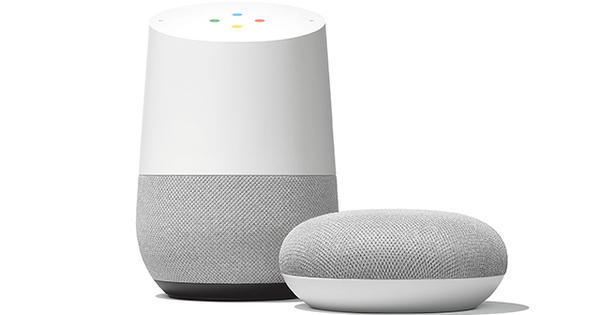Thanks to a thermostat, we know how warm it is and we can keep the temperature comfortable. We often know nothing about the air quality in the house, although this is very important for your comfort and health. The Foobot should help you monitor the air quality in your home.
foobot
Price
€ 199,-
Sensors
VOC, particulate matter, humidity, temperature
wireless
802.11b/g/n
app
iOS and Android
Dimensions
17.2 x 7.2cm
Weight
475 grams
Website
foobot.io
7 Score 70- Pros
- Simple design
- Air quality indication with lighting
- Link with IFTTT
- Clear app
- Negatives
- No CO . display
- CO2 display recalculated
- Price
The Foobot is an air quality sensor with accompanying app and is a standing white cylinder that is 17 centimeters high. The front contains a light strip that turns (partially) blue or orange depending on the air quality. This allows you to read the air quality without an app. The installation is not very difficult, but somewhat different. You have to turn the device upside down to connect it to your Wi-Fi network. Once you have entered the details of your wireless network, you can set the Foobot back to normal and the device is ready for use. Also read: Home automation - This is how you make all your devices work together
After installation, the Foobot takes about six days for the sensors to work properly. Although this is neatly stated in the manual, this information is not shown in the app. Confusing, because all sensors seem to do something right away. For example, according to the FooBot, there were no fine dust particles in my house in the first six days. When the calibration period was over after six days, it turned out that there were (of course) particulate matter in my house. It was striking that particulate matter values were suddenly shown for the previous days as well. That the sensors need six days to 'warm up' is not a big deal, but this should be clearly shown in the app.
Foobot measures volatile substances and particulate matter
The Foobot contains two sensors that measure air quality. The first is a VOC sensor. VOC stands for volatile organic compounds in Dutch. They are hydrocarbons that simply evaporate. The concentration is given in ppb, parts per billion. In addition, the Foobot contains a particulate matter sensor that measures PM2.5 particulate matter with an aerodynamic diameter of less than 2.5 micrometers. Such particles can penetrate deep into the lungs and are harmful to health.
The amount of particulate matter is given in µg/m3 (micrograms per cubic metre). Those values probably don't tell you much, luckily Foobot indicates which values these measurements may have for excellent, good, fair or bad air quality. In addition to sensors for volatile substances and particulate matter, the Foobot also contains sensors for temperature and humidity. Humidity in particular has an influence on air quality, since too high humidity can lead to mold formation.
Foobot does not measure CO2 and CO
In addition to the presence of volatile organic compounds, the app also shows the presence of CO2. If you click on this value, it will be stated that the value has been recalculated on the basis of the volatile organic compounds. The Foobot therefore does not measure the presence of CO2, the manufacturer assumes that a certain VOC value probably also includes a certain CO2 value. We checked why Foobot is doing this and the answer is that CO2 is strongly linked to human presence.
In addition, many ventilation systems already use control based on the CO2 concentration. In this way you establish the relationship between many people more quickly and better ventilation. The hazardous CO is also mentioned on the packaging. Unfortunately, the Foobot doesn't actually do anything with CO. It is simply one of the gases to which the VOC sensor is sensitive. Any CO is thus shown as part of the total VOC value. A bit of a shame, because CO is mentioned separately on the packaging, although with two asterisks. Foobot has informed us that they are testing a separate CO sensor for a possible new version.
Quick insight into air quality
Based on the sensors, the Foobot determines the air quality, which is expressed on a scale from 0 to 100, with a lower value representing better air quality. If the air quality is excellent or good, the app will be blue. If your air quality is moderate or bad, the app is orange. Furthermore, the device itself contains a light strip that also turns blue or orange. The light strip is divided into three parts: complete, two thirds and one third. Combined with the two colours, this allows six levels of air quality to be displayed: from fully blue (excellent) to fully orange (poor). You can also adjust the brightness of the lighting or switch it off at certain times. Nice, because the standard lighting is much too bright for my taste. You can also view the history in the app, both for the overall air quality and the individual values. The data in the Foobot is not completely real-time, normally the app is updated every five minutes. By tapping the top twice, the information in the app is updated in real time.
Link with IFTTT
The Foobot can be linked to IFTTT and could then be linked to a ventilation system, for example. You can also have something like a Hue light glow red if the air quality gets too bad so that you have visual feedback in other rooms as well. The usefulness may be somewhat limited, because who has an IFTTT linked ventilation system? But it is in any case nice if a smart device can be linked to other equipment. What is funny in itself is that the knock sensor in the Foobot that normally sends recent data to the app can also be linked to an action. For example, by tapping on the Foobot, I was able to turn on the Hue lighting. In addition to IFTTT, an API is also available for developers.
Conclusion
The Foobot reminds you to open a window or turn up the ventilation system if the air quality deteriorates unnoticed. Even without consulting the app, you can see how the air quality is based on the lighting on the device. It is in itself quite useful to have an indication of the air quality, but is that worth 200 euros? In any case, the Foobot would have more added value for me if the dangerous carbon monoxide (CO) would be measured and displayed. Especially in a bedroom you would really benefit from this in combination with an alarm. All in all, the Foobot is quite an interesting product, but I find it quite expensive for an air quality meter without specific support for CO and CO2.

